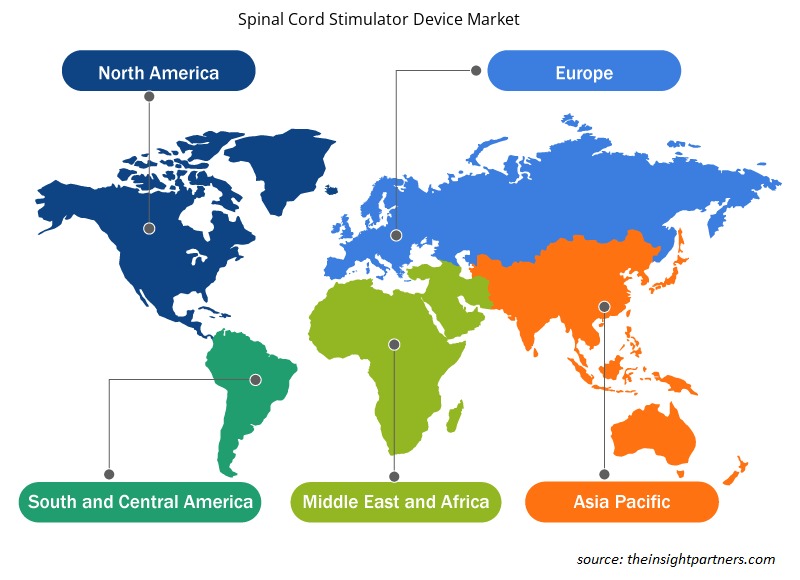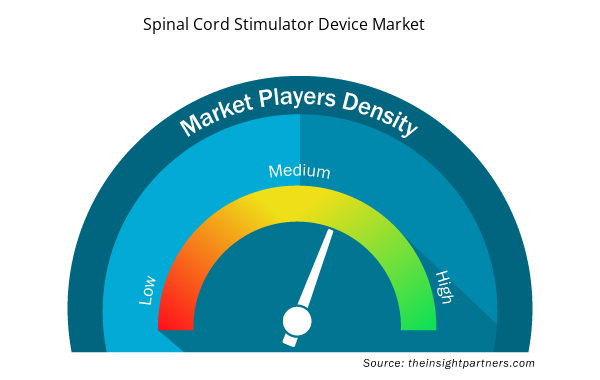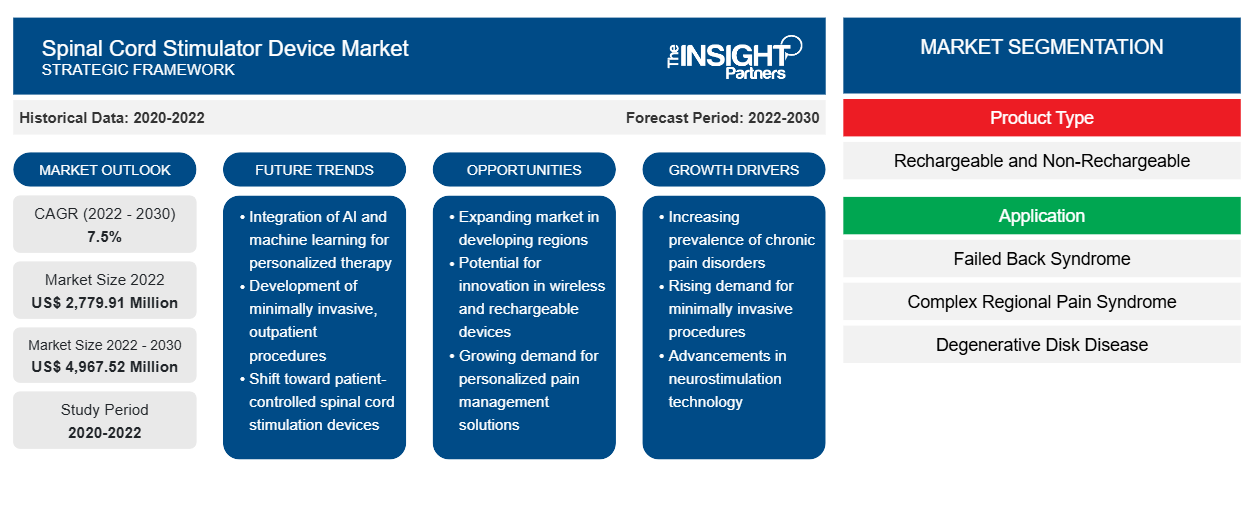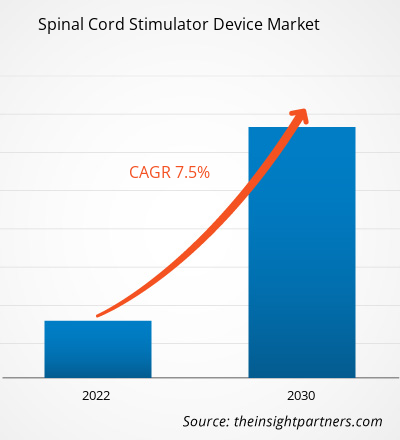[Informe de investigación] Se espera que el mercado de dispositivos estimuladores de la médula espinal crezca de US$ 2.779,91 millones en 2022 a US$ 4.967,52 millones en 2030; se anticipa que registre una CAGR del 7,5% entre 2022 y 2030.
Perspectivas del mercado y opinión de analistas:
Un dispositivo de estimulación de la médula espinal es un dispositivo implantado que alivia el dolor mediante la transmisión de señales eléctricas de bajo nivel directamente a la médula espinal. El estimulador se utiliza principalmente cuando los tratamientos no quirúrgicos para el dolor no proporcionan un alivio suficiente. Además, el dispositivo puede mejorar la calidad de vida y el sueño en general. Como suele prescribirse junto con otros tratamientos para el tratamiento del dolor, suprime eficazmente la necesidad de analgésicos. El tamaño del mercado de dispositivos de estimulación de la médula espinal se está expandiendo con el aumento del número de lesiones de la médula espinal (LME) y la disponibilidad de tratamientos innovadores.
Factores impulsores del crecimiento y desafíos:
Según la Biblioteca Nacional de Medicina (NLM), entre 250.000 y 500.000 pacientes sufren lesiones de la médula espinal cada año en todo el mundo. Según un informe publicado por la Asociación para la Investigación, Rehabilitación y Reintegración de Lesiones de la Médula Espinal (Aspire, Reino Unido), aproximadamente 2.500 personas son diagnosticadas con LME anualmente en el Reino Unido. Actualmente, aproximadamente 50.000 personas viven con estas lesiones en el Reino Unido. El Centro Nacional de Estadísticas de Lesiones de la Médula Espinal (NSCISC) estima que aproximadamente 320.000 personas viven con LME traumáticas en los EE. UU. Un número elevado de casos se atribuye a las competiciones de motocross y motociclismo que emergen como las actividades deportivas más populares en todo el mundo, según el informe del Instituto Nacional de Salud (NIH).
Además, estas lesiones son comunes en la población de edad avanzada. Según los datos presentados en el marco de la recopilación de indicadores de desarrollo del Banco Mundial en 2022, el 22,41% de la población de Alemania tiene más de 65 años. Un artículo publicado por MDPI menciona que la tasa de prevalencia de lesiones traumáticas de la médula espinal es de aproximadamente 500 por millón de habitantes y la tasa de incidencia se eleva a 13 por millón a nivel mundial.
Las lesiones de la médula espinal tienen efectos que cambian la vida de los pacientes lesionados y sus familias. La creciente incidencia de lesiones de la médula espinal y el tratamiento correspondiente de los pacientes en los hospitales se acompaña de al menos un reingreso del paciente cada año. Esto se debe a que las lesiones de la médula espinal no se tratan de inmediato. Las causas de rehospitalización incluyen infecciones de las vías respiratorias y urinarias y fracturas que ocurren durante las actividades deportivas de motociclismo. Con el aumento de las lesiones de la médula espinal y la disponibilidad de infraestructura bien desarrollada en los centros de tratamiento que ofrecen programas de rehabilitación, la demanda de dispositivos de estimulación de la médula espinal está aumentando en los centros especializados o de rehabilitación, lo que impulsa el crecimiento del dispositivo de estimulación de la médula espinal.
Personalice este informe según sus necesidades
Obtendrá personalización en cualquier informe, sin cargo, incluidas partes de este informe o análisis a nivel de país, paquete de datos de Excel, así como también grandes ofertas y descuentos para empresas emergentes y universidades.
- Obtenga las principales tendencias clave del mercado de este informe.Esta muestra GRATUITA incluirá análisis de datos, desde tendencias del mercado hasta estimaciones y pronósticos.
Segmentación y alcance del informe:
El mercado de dispositivos estimuladores de la médula espinal se divide en función del tipo de producto, la aplicación, el usuario final y la geografía. Según el tipo de producto, el mercado de dispositivos estimuladores de la médula espinal se bifurca en recargables y no recargables. El mercado de dispositivos estimuladores de la médula espinal está segmentado según la aplicación en síndrome de espalda fallida, síndrome de dolor regional complejo, enfermedad degenerativa del disco y otros. En términos de usuario final, el mercado se clasifica en hospitales, centros de cirugía ambulatoria y otros. Según la geografía, el mercado de dispositivos estimuladores de la médula espinal está segmentado en América del Norte (EE. UU., Canadá y México), Europa (Reino Unido, Alemania, Francia, Italia, España, Rusia y resto de Europa), Asia Pacífico (China, Japón, India, Corea del Sur, Australia, Sudeste Asiático y Resto de Asia Pacífico), Oriente Medio y África (EAU, Arabia Saudita, Sudáfrica y Resto de Oriente Medio y África) y América del Sur y Central (Brasil, Argentina y Resto de América del Sur y Central).
Análisis segmental:
El mercado de dispositivos de estimulación de la médula espinal está segmentado en función de la aplicación en síndrome de espalda fallida, síndrome de dolor regional complejo, enfermedad degenerativa del disco y otros. El segmento del síndrome de dolor regional complejo tuvo la mayor participación de mercado en 2022. Se espera que registre la CAGR más alta durante 2022-2030. El síndrome de dolor regional complejo (SDRC) implica dolor e inflamación prolongados que se producen debido a una lesión u otros eventos médicos como cirugía, trauma, accidente cerebrovascular y ataque cardíaco. El SDRC puede ocurrir en cualquier parte del cuerpo, generalmente afectando el brazo, la pierna, la mano o el pie. Es más probable que ocurra en cualquier persona a cualquier edad, y la inflamación se acerca a un pico después de los 40 años. La mayoría de los casos de SDRC son causados por pequeñas fibras nerviosas periféricas de fibra C dañadas o que funcionan incorrectamente, que llevan señales de dolor al cerebro. El SDRC a menudo permanece sin diagnosticar con el desarrollo de pequeños coágulos, que a veces bloquean el flujo sanguíneo a los nervios y los lesionan.
Mercado de dispositivos de estimulación de la médula espinal por aplicación: 2022 y 2030
Análisis regional:
Según la geografía, el mercado de dispositivos de estimulación de la médula espinal se divide en América del Norte, Europa, Asia Pacífico, Oriente Medio y África, y América del Sur y Central. América del Norte es el mayor contribuyente al crecimiento del mercado mundial de dispositivos de estimulación de la médula espinal. Se espera que Asia Pacífico registre la CAGR más alta en el mercado de dispositivos de estimulación de la médula espinal entre 2022 y 2030. La incidencia en continuo aumento de las lesiones de la médula espinal está asociada con el crecimiento de este mercado. Actualmente, las lesiones de la médula espinal suponen una importante carga de salud en los países de América del Norte. Según Spinal Cord Inc., aproximadamente 18.000 personas en los EE. UU. sufren estas lesiones cada año.
Perspectivas regionales del mercado de dispositivos de estimulación de la médula espinal
Los analistas de Insight Partners explicaron en detalle las tendencias y los factores regionales que influyen en el mercado de dispositivos de estimulación de la médula espinal durante el período de pronóstico. Esta sección también analiza los segmentos y la geografía del mercado de dispositivos de estimulación de la médula espinal en América del Norte, Europa, Asia Pacífico, Oriente Medio y África, y América del Sur y Central.

- Obtenga datos regionales específicos para el mercado de dispositivos estimuladores de la médula espinal
Alcance del informe de mercado sobre dispositivos de estimulación de la médula espinal
| Atributo del informe | Detalles |
|---|---|
| Tamaño del mercado en 2022 | US$ 2.779,91 millones |
| Tamaño del mercado en 2030 | US$ 4.967,52 millones |
| CAGR global (2022-2030) | 7,5% |
| Datos históricos | 2020-2022 |
| Período de pronóstico | 2022-2030 |
| Segmentos cubiertos | Por tipo de producto
|
| Regiones y países cubiertos | América del norte
|
| Líderes del mercado y perfiles de empresas clave |
|
Densidad de actores del mercado: comprensión de su impacto en la dinámica empresarial
El mercado de dispositivos de estimulación de la médula espinal está creciendo rápidamente, impulsado por la creciente demanda de los usuarios finales debido a factores como la evolución de las preferencias de los consumidores, los avances tecnológicos y una mayor conciencia de los beneficios del producto. A medida que aumenta la demanda, las empresas amplían sus ofertas, innovan para satisfacer las necesidades de los consumidores y aprovechan las tendencias emergentes, lo que impulsa aún más el crecimiento del mercado.
La densidad de actores del mercado se refiere a la distribución de las empresas o firmas que operan dentro de un mercado o industria en particular. Indica cuántos competidores (actores del mercado) están presentes en un espacio de mercado determinado en relación con su tamaño o valor total de mercado.
Las principales empresas que operan en el mercado de dispositivos estimuladores de la médula espinal son:
- Corporación Boston Scientific
- Corporación Nevro
- Laboratorios Abbott
- Corporación Médica Cirtec
- Medtronic S.A.
Descargo de responsabilidad : Las empresas enumeradas anteriormente no están clasificadas en ningún orden particular.

- Obtenga una descripción general de los principales actores clave del mercado de dispositivos estimuladores de la médula espinal
Desarrollos industriales y oportunidades futuras:
A continuación se enumeran las iniciativas clave de los principales actores que operan en el mercado de dispositivos estimuladores de la médula espinal:
- En agosto de 2022, Abbott Laboratories recibió la aprobación de la FDA de EE. UU. para su sistema Proclaim Plus SCS para tratar el dolor crónico. La tecnología de estimulación BurstDR permite que el dispositivo brinde un alivio superior del dolor. Ofrece la terapia FlexBurst360 que ofrece cobertura del dolor en el tronco y las extremidades; el dispositivo se puede programar según las necesidades terapéuticas cambiantes del paciente.
- En diciembre de 2022, el sistema de estimulación de la médula espinal (SCS) Eterna de Abbott Laboratories estará disponible para tratar el dolor crónico. La estimulación BurstDR de dosis baja de Abbott, una tecnología de forma de onda de SCS de dosis baja patentada con la mayor evidencia clínica, ha sido aprobada por la FDA. Además, se ha demostrado que la técnica ayuda a reducir el dolor un 23 % más que los resultados producidos por los métodos basados en la tecnología de forma de onda convencional.
Panorama competitivo y empresas clave:
Algunas de las empresas más importantes que operan en el mercado de dispositivos de estimulación de la médula espinal son Boston Scientific Corp; Nevro Corp; Abbott Laboratories; Cirtec Medical Corp; Medtronic Plc; Biotronik SE & Co KG; Curonix LLC; Nalu Medical, Inc.; y Synapse Biomedical Inc. Estas empresas se centran en el lanzamiento de nuevos productos y en la expansión geográfica para satisfacer la demanda mundial de los consumidores y aumentar su gama de productos en carteras especializadas. Su presencia global les permite atender a una gran base de clientes, lo que facilita posteriormente la expansión del mercado.
- Análisis histórico (2 años), año base, pronóstico (7 años) con CAGR
- Análisis PEST y FODA
- Tamaño del mercado Valor/volumen: global, regional, nacional
- Industria y panorama competitivo
- Conjunto de datos de Excel


- Ketogenic Diet Market
- Clear Aligners Market
- Photo Editing Software Market
- Medical Second Opinion Market
- Investor ESG Software Market
- Online Recruitment Market
- Industrial Inkjet Printers Market
- Legal Case Management Software Market
- Social Employee Recognition System Market
- Aircraft Wire and Cable Market

Report Coverage
Revenue forecast, Company Analysis, Industry landscape, Growth factors, and Trends

Segment Covered
This text is related
to segments covered.

Regional Scope
North America, Europe, Asia Pacific, Middle East & Africa, South & Central America

Country Scope
This text is related
to country scope.
Preguntas frecuentes
Based on product type, the spinal cord stimulator device market is bifurcated into rechargeable and non-rechargeable. The rechargeable segment held a larger market share in 2022 and is expected to record a significant CAGR during 2022–2030. In terms of end users, the spinal cord stimulator device market is categorized into hospitals, ambulatory surgery centers, and others. The hospital segment held the largest share of the market in 2022 and is anticipated to register the highest CAGR during 2022–2030.
Based on geography, the spinal cord stimulator device market is segmented into North America (the US, Canada, and Mexico), Europe (the UK, Germany, France, Italy, Spain, and the Rest of Europe), Asia Pacific (China, Japan, India, South Korea, Australia, and the Rest of Asia Pacific), the Middle East & Africa (the UAE, Saudi Arabia, South Africa, and Rest of the Middle East & Africa), and South & Central America (Brazil, Argentina, and the Rest of South & Central America). North America is the largest contributor to the growth of the global spinal cord stimulator device market. Asia Pacific is expected to register the highest CAGR in the spinal cord stimulator device market from 2022 to 2030.
The spinal cord stimulator device market majorly consists of players such as Boston Scientific Corp, Nevro Corp, Abbott Laboratories, Cirtec Medical Corp, Medtronic Plc, Biotronik SE & Co KG, Curonix LLC, Nalu Medical Inc, and Synapse Biomedical Inc
The increasing cases of spinal cord injuries and strategic initiatives by companies bolster the spinal cord stimulator devices market size. However, the high cost associated with spinal cord stimulator devices hinders the market growth.
A spinal cord stimulation device is an implanted device that relieves pain by transmitting low-level electrical signals directly into the spinal cord. The stimulator is mostly used after nonsurgical pain treatments fail to provide sufficient relief. Additionally, the device can improve the overall quality of life and sleep. As it is typically prescribed along with other pain management treatments, it effectively suppresses the need for pain medicines. The spinal cord stimulator device market size is expanding with the rising number of spinal cord injuries (SCIs) and the availability of innovative treatments.
Trends and growth analysis reports related to Life Sciences : READ MORE..
The List of Companies - Spinal Cord Stimulator Device Market
- Boston Scientific Corp
- Nevro Corp
- Abbott Laboratories
- Cirtec Medical Corp
- Medtronic Plc
- Biotronik SE & Co KG
- Curonix LLC
- Nalu Medical, Inc.
- Synapse Biomedical Inc
The Insight Partners performs research in 4 major stages: Data Collection & Secondary Research, Primary Research, Data Analysis and Data Triangulation & Final Review.
- Data Collection and Secondary Research:
As a market research and consulting firm operating from a decade, we have published and advised several client across the globe. First step for any study will start with an assessment of currently available data and insights from existing reports. Further, historical and current market information is collected from Investor Presentations, Annual Reports, SEC Filings, etc., and other information related to company’s performance and market positioning are gathered from Paid Databases (Factiva, Hoovers, and Reuters) and various other publications available in public domain.
Several associations trade associates, technical forums, institutes, societies and organization are accessed to gain technical as well as market related insights through their publications such as research papers, blogs and press releases related to the studies are referred to get cues about the market. Further, white papers, journals, magazines, and other news articles published in last 3 years are scrutinized and analyzed to understand the current market trends.
- Primary Research:
The primarily interview analysis comprise of data obtained from industry participants interview and answers to survey questions gathered by in-house primary team.
For primary research, interviews are conducted with industry experts/CEOs/Marketing Managers/VPs/Subject Matter Experts from both demand and supply side to get a 360-degree view of the market. The primary team conducts several interviews based on the complexity of the markets to understand the various market trends and dynamics which makes research more credible and precise.
A typical research interview fulfils the following functions:
- Provides first-hand information on the market size, market trends, growth trends, competitive landscape, and outlook
- Validates and strengthens in-house secondary research findings
- Develops the analysis team’s expertise and market understanding
Primary research involves email interactions and telephone interviews for each market, category, segment, and sub-segment across geographies. The participants who typically take part in such a process include, but are not limited to:
- Industry participants: VPs, business development managers, market intelligence managers and national sales managers
- Outside experts: Valuation experts, research analysts and key opinion leaders specializing in the electronics and semiconductor industry.
Below is the breakup of our primary respondents by company, designation, and region:

Once we receive the confirmation from primary research sources or primary respondents, we finalize the base year market estimation and forecast the data as per the macroeconomic and microeconomic factors assessed during data collection.
- Data Analysis:
Once data is validated through both secondary as well as primary respondents, we finalize the market estimations by hypothesis formulation and factor analysis at regional and country level.
- Macro-Economic Factor Analysis:
We analyse macroeconomic indicators such the gross domestic product (GDP), increase in the demand for goods and services across industries, technological advancement, regional economic growth, governmental policies, the influence of COVID-19, PEST analysis, and other aspects. This analysis aids in setting benchmarks for various nations/regions and approximating market splits. Additionally, the general trend of the aforementioned components aid in determining the market's development possibilities.
- Country Level Data:
Various factors that are especially aligned to the country are taken into account to determine the market size for a certain area and country, including the presence of vendors, such as headquarters and offices, the country's GDP, demand patterns, and industry growth. To comprehend the market dynamics for the nation, a number of growth variables, inhibitors, application areas, and current market trends are researched. The aforementioned elements aid in determining the country's overall market's growth potential.
- Company Profile:
The “Table of Contents” is formulated by listing and analyzing more than 25 - 30 companies operating in the market ecosystem across geographies. However, we profile only 10 companies as a standard practice in our syndicate reports. These 10 companies comprise leading, emerging, and regional players. Nonetheless, our analysis is not restricted to the 10 listed companies, we also analyze other companies present in the market to develop a holistic view and understand the prevailing trends. The “Company Profiles” section in the report covers key facts, business description, products & services, financial information, SWOT analysis, and key developments. The financial information presented is extracted from the annual reports and official documents of the publicly listed companies. Upon collecting the information for the sections of respective companies, we verify them via various primary sources and then compile the data in respective company profiles. The company level information helps us in deriving the base number as well as in forecasting the market size.
- Developing Base Number:
Aggregation of sales statistics (2020-2022) and macro-economic factor, and other secondary and primary research insights are utilized to arrive at base number and related market shares for 2022. The data gaps are identified in this step and relevant market data is analyzed, collected from paid primary interviews or databases. On finalizing the base year market size, forecasts are developed on the basis of macro-economic, industry and market growth factors and company level analysis.
- Data Triangulation and Final Review:
The market findings and base year market size calculations are validated from supply as well as demand side. Demand side validations are based on macro-economic factor analysis and benchmarks for respective regions and countries. In case of supply side validations, revenues of major companies are estimated (in case not available) based on industry benchmark, approximate number of employees, product portfolio, and primary interviews revenues are gathered. Further revenue from target product/service segment is assessed to avoid overshooting of market statistics. In case of heavy deviations between supply and demand side values, all thes steps are repeated to achieve synchronization.
We follow an iterative model, wherein we share our research findings with Subject Matter Experts (SME’s) and Key Opinion Leaders (KOLs) until consensus view of the market is not formulated – this model negates any drastic deviation in the opinions of experts. Only validated and universally acceptable research findings are quoted in our reports.
We have important check points that we use to validate our research findings – which we call – data triangulation, where we validate the information, we generate from secondary sources with primary interviews and then we re-validate with our internal data bases and Subject matter experts. This comprehensive model enables us to deliver high quality, reliable data in shortest possible time.


 Obtenga una muestra gratuita de este informe
Obtenga una muestra gratuita de este informe